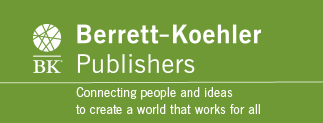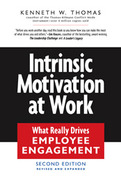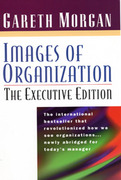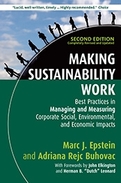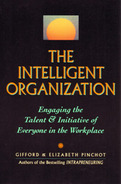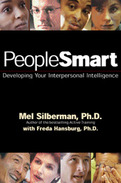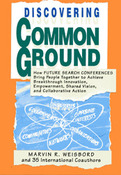• By the coauthor of Thomas-Kilmann Conflict Mode Instrument (6 million copies sold)
• Accessible, practical, and based on solid research, this book reveals how and why today's workplace requires more self-management, and why intrinsic motivation is now essential
• Details four intrinsic rewards that make work energizing and fulfilling
What motivates people to do their best work in any endeavor they undertake? Management theory and practice has traditionally focused on elements that Kenneth Thomas calls 'extrinsic motivators': pay, benefits, status, bonuses, commissions, pension plans, expense budgets, and the like. While these are powerful motivators, particularly in command/control job situations where workers have little or no say in how the job is managed, by themselves they are no longer enough. In today's organizations, where managers expect workers and teams to self-manage their work, intrinsic rewards are essential.
This breakthrough book provides the first comprehensive treatment of intrinsic motivation in the workplace-the psychological rewards workers get directly from the work itself-offering clear advice on how companies can harness its tremendous power to develop a more committed, self-managing workforce. Written in an engaging, accessible style and grounded in solid academic research, the book provides a diagnostic framework for addressing problems of intrinsic motivation and essential ways to build it.
Thomas describes four intrinsic rewards needed to energize today's employees:
• A sense of purpose or meaningfulness
• The ability to choose how the tasks are performed
• A sense of competence from performing work activities well, and
• A sense of progress.
Thomas offers detailed information on these rewards, together with the building blocks leaders and workers can use to create them. Finally, he spells out the practical implications for executives, managers, and employees themselves.
Intrinsic Motivation at Work makes a major contribution to the topic of work motivation-one that is based on a keen understanding of the changing requirements of today's workplace and the limitations of other motivational models. The paradigm and practical approaches this path-breaking book provides will help business leaders build motivation at every level of their organizations.
Ken is also the co-author of the new assessment, the Work Engagement Profile, which measures four intrinsic rewards that fuel employee engagement in the workplace, as discussed in Intrinsic Motivation at Work. The WEP is published by CPP, Inc.
- An international bestselling classic (over 250,000 copies sold of the first edition), newly revised for today's managers
- Recognized as one of the most influential management texts of the last decade, Images of Organization revolutionized the way we look at organizations
- This classic book has been revised, updated, and abridged to meet the needs of today's managers
- Copublished with Sage Publications
This pioneering work is based on a simple premise with profound implications: All organization and management theories are based on images, or metaphors, with paradoxical effects: they can create profound insights but also grotesque distortions. Morgan makes his case by showing how theories of organization and management have been shaped by a few powerful metaphors-most notably those of the machine, the living organism, culture, politics, and, more recently, the learning organization, complexity, chaos, flux, and change. With this seminal work, he shows how managers can avoid superficial management fads by selecting metaphors wisely and then using them creatively to generate insights, ideas, and new ways of working.
As the first book to offer a concrete method for integrating the strengths and overcoming the weaknesses of competing management perspectives, Images of Organization has established itself as a classic and influenced management thinking throughout the world. The new edition retains all the vitality of the original and has been updated to integrate significant research of the last decade. It has also been abridged and revised to increase its accessibility and usefulness for managerial audiences.
Images of Organization-The Executive Edition is a monumental work. No other management book covers so much ground while developing the implications for management with such force. Morgan is a master of the links between theory and practice. He has a gift for stripping complex ideas to fundamentals, and for fusing a kaleidoscope of insights into practical schemes for reading and shaping organizational life. This essential volume provides the kind of organizational "radar" system managers need to negotiate the demands of the 21st century. It is a resource they will turn to again and again.
- An international bestselling classic (over 250,000 copies sold of the first edition), newly revised for today's managers
- Recognized as one of the most influential management texts of the last decade, Images of Organization revolutionized the way we look at organizations
- This classic book has been revised, updated, and abridged to meet the needs of today's managers
- Copublished with Sage Publications
Offers a complete guide to the details of implementing and measuring the impact of CSR initiatives
Most companies today have some commitment to corporate social responsibility, but implementing these initiatives can be particularly challenging. While a lot has been written on ethical and strategic factors, there is still a dearth of information on the practical nuts and bolts. And whereas with most other organizational initiatives the sole objective is improved financial performance, sustainability broadens the focus to include social and environmental performance, which is much more difficult to measure.Now updated throughout with new examples and new research, this is a complete guide to implementing and measuring the effectiveness of sustainability initiatives. It draws on Marc Epstein's and new coauthor Adriana Rejc Buhovac's solid academic foundation and extensive consulting work and includes best practices from dozens of companies in Europe, Asia, North America, South America, Australia, and Africa. This is the ultimate how-to guide for corporate leaders, strategists, academics, sustainability consultants, and anyone else with an interest in actually putting sustainability ideas into practice and making sure they accomplish their goals.
- A comprehensive guide to implementing and evaluating corporate sustainability initiatives
- Combines a thorough grounding in the latest research with the best practices of 100 organizations worldwide, including prominent companies such as Canon, Coca-Cola, Dell, FedEx, General Mills, Johnson & Johnson, Nestle, Starbucks, Warner Brothers
The best practices in corporate social responsibility (CSR) are no longer the exclusive domain of companies like Ben & Jerry's or the Body Shop; now even companies like GE and Wal-Mart are making significant financial and organizational commitments to social and environmental issues. But senior executives are realizing that implementing sustainability is particularly challenging. While a lot has been written on ethical and strategic factors, there is a dearth of information on the practical nuts and bolts of implementation and virtually nothing on how to measure the results.
In Making Sustainability Work, Marc Epstein builds on his influential and highly respected previous work to produce the ultimate how-to guide for corporate leaders, strategists, academics, sustainability consultants, and anyone else with an interest in actually putting sustainability ideas into practice.
Though bureaucracy appears on almost every "biggest problems with business" list, most management books simply suggest ways to make it work better. This book shows how to replace bureaucracy with fundamentally different principles for organizing and coordinating work.
Gifford and Elizabeth Pinchot confront head-on the key organizational issues that are threatening the very existence of today's corporations. They assert that "bureaucracy is no more appropriate to the information age than serfdom was to the industrial era. Only freedom and community will work."
The Pinchots describe "intelligent organizations" that make full use of the intelligence of all employees. By developing and engaging the intelligence, business judgment, and wide-system responsibility of all its members, an organization can respond far more effectively to customers, partners, and competitors. The Pinchots provide a far-reaching guide to:
o establishing internal free markets
o liberated teams
o community in the workplace
o equality and diversity
o democratic self-rule
o multiple sources of authority
o limited corporate government
The Pinchots support the sweeping changes they propose with numerous examples of how these changes are already being implemented in such diverse organizations as AT&T, the Canadian National Railroad, DuPont, Russian entrepreneurial firms, Hewlett-Packard, and the U.S. Forest Service.
- Everyone complains about bureaucracy. Here's how to replace it with more humane and effective systems of organization
- From the authors of Intrapreneuring, one of the bestselling and most influential business books of the 1980s
- Originally published in hardcover as The End of Bureaucracy and the Rise of the Intelligent Organization
2000
- Offers user-friendly tips, helpful self-assessment tools, motivational checklists, and practical exercises to help readers build their interpersonal intelligence skills
- Provides an effective, step-by-step plan to make every relationship-with supervisors, coworkers, teammates, spouses, partners, children, relatives, and friends-more successful and fulfilling
- Presents eight essential interpersonal intelligence skills and a powerful five-step process for developing each one
This book brings together cases from around the world of a breakthrough new approach to strategic planning, empowerment, consensus building, and whole systems improvement. Marvin Weisbord and 35 international coauthors show how all types of business, government, and nonprofit organizations are successfully using this approach to create shared vision, innovation, commitment, and collaborative action that exceed what people thought possible.
In this approach-called "future searches" or "search conferences"-people with diverse interests who have a stake in an organization or issue come together for two or three days to explore their mutual past, present, and future in a global context. Using a self-managing format, they seek common ground among their varied interests, invent ideal futures rather than work old problems, and generate creative strategies, action plans, and commitment.
- Copublished with Industrial Engineering and Management Press
